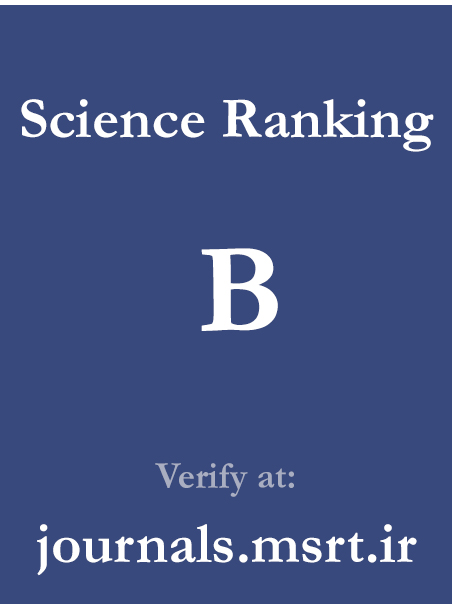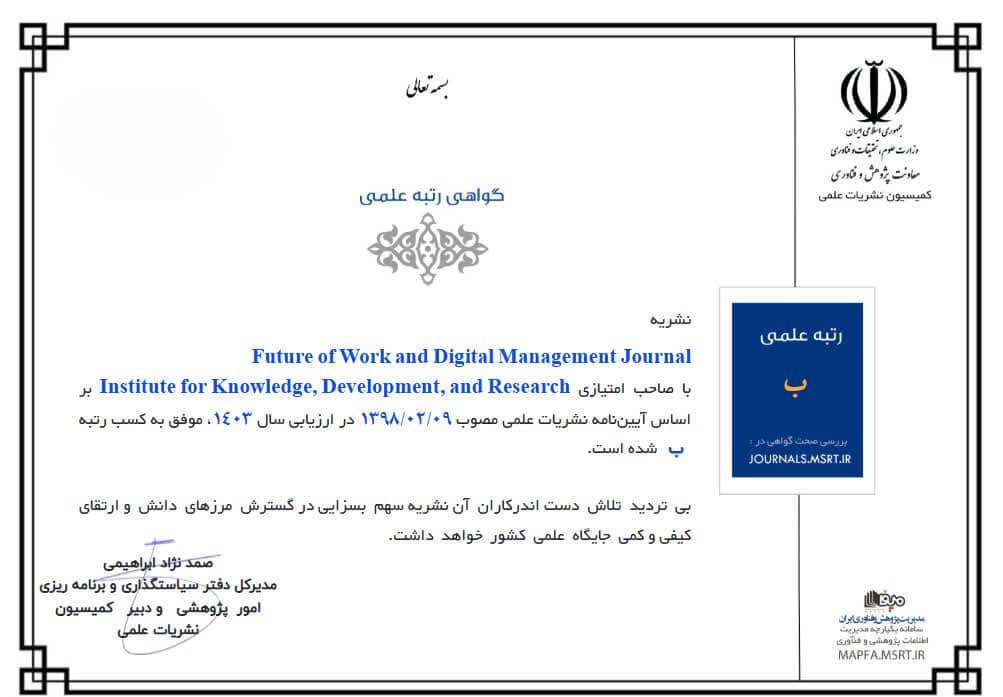Modeling the Effect of Self-Brand Distinctiveness and Self-Brand Expression on Personal Brand Performance
Keywords:
Self-brand distinctiveness; Self-brand expression; Personal branding; Personal brand performance; Brand differentiation; Digital identity.Abstract
This study aimed to model and examine the effect of self-brand distinctiveness and self-brand expression on personal brand performance, emphasizing the mediating role of personal branding among creative professionals in Tehran. This research employed an applied, descriptive-correlational design using a field survey approach. The statistical population comprised contemporary artists, designers, architects, and art students in Tehran. A sample of 234 respondents was selected through simple random sampling, based on Cochran’s formula. Data were collected via a structured questionnaire adapted from validated scales of prior studies. The questionnaire measured four constructs—self-brand distinctiveness, self-brand expression, personal branding, and personal brand performance—using a five-point Likert scale. Reliability and validity were confirmed through Cronbach’s Alpha, Composite Reliability (CR), and Average Variance Extracted (AVE) in SmartPLS. Data analysis was performed using the Partial Least Squares Structural Equation Modeling (PLS-SEM) method to test the hypothesized relationships among variables. Results revealed significant positive relationships among all studied variables. Self-brand distinctiveness exerted a strong direct effect on personal branding (β = 0.651, t = 9.28, p < 0.01) and also positively influenced self-brand expression (β = 0.532, t = 6.98, p < 0.01). Additionally, self-brand expression significantly affected personal branding (β = 0.204, t = 2.56, p < 0.01). The relationship between personal branding and personal brand performance was the strongest (β = 0.813, t = 26.65, p < 0.01), confirming that personal branding serves as a crucial mediator in translating distinctiveness and expression into enhanced performance outcomes. The overall model demonstrated high explanatory power and satisfactory goodness-of-fit indices. The findings highlight that self-brand distinctiveness and expression jointly strengthen personal brand performance through their influence on personal branding. Developing a clear and consistent personal identity, combined with authentic self-expression, enhances visibility, trust, and recognition in professional contexts. Personal branding thus serves as the strategic link connecting identity differentiation and expressive communication with tangible performance outcomes.
Downloads
References
[1] Z. Roshanazadeh, A. Kordnaeij, and Mansourimoayyed, "The Impact of Brand Innovation on Brand Resonance with the Mediating Role of Brand Experience (Case Study: Pasargad Bank Customers in Tehran)," Modern Marketing Research, vol. 15, no. 1, pp. 1-24, 2025. [Online]. Available: https://nmrj.ui.ac.ir/article_29480_en.html?lang=fa.
[2] B. Shweta and P. S. Dev, "Impact of Social Media Marketing in Customer Brand Preference," International Journal for Multidisciplinary Research, vol. 6, no. 2, 2024, doi: 10.36948/ijfmr.2024.v06i02.16467.
[3] T. Rastogi, B. Agarwal, and G. Gopal, "Exploring the nexus between sustainable marketing and customer loyalty with the mediating role of brand image," Journal of Cleaner Production, vol. 14, no. 1, pp. 108-119, 2024, doi: 10.1016/j.jclepro.2024.140808.
[4] A. Fazel and A. Harandi, "Social Media Marketing and Brand Equity of Iranian Tire Products: Explaining the Role of Corporate Capabilities and Customer Value Co-creation," [Volume 28, Issue 111], pp. 25-44, 2024.
[5] A. Caruana and J. Vella, "Communal-brand connection and service loyalty: the mediation effect of corporate reputation and customer satisfaction among retail banking customers," International Journal of Bank Marketing, vol. 42, no. 7, pp. 1472-1491, 2024, doi: 10.1108/IJBM-01-2024-0012.
[6] B. A. U. A. A. Ibrahim, "The era of Instagram expansion: Matching social media marketing activities and brand loyalty through customer relationship quality," Journal of Marketing Communications, vol. 29, no. 1, pp. 1-25, 2023, doi: 10.1080/13527266.2021.1984279.
[7] J. Yu and Y. Zhang, "The impact of influencer marketing on customer brand engagement: Evidence from beauty brands," Journal of Business Research, vol. 177, no. November 2023, p. 113951, 2023, doi: 10.1016/j.jbusres.2023.113951.
[8] L. Phan Tan, "Customer participation, positive electronic word-of-mouth intention and repurchase intention: The mediation effect of online brand community trust," Journal of Marketing Communications, vol. 30, no. 7, pp. 792-809, 2024, doi: 10.1080/13527266.2023.2177709.
[9] M. Shukla, R. Misra, and D. Singh, "Exploring relationship among semiotic product packaging, brand experience dimensions, brand trust and purchase intentions in an Asian emerging market," Asia Pacific Journal of Marketing and Logistics, vol. 35, no. 2, pp. 249-265, 2023, doi: 10.1108/APJML-10-2021-0718.
[10] Y. Huang and C. Bunchapattanasakda, "Influence of Marketing Mix Strategy on Brand Equity Enhancement of Chinese Dried Forest Fruit Brands Based on Customer Mind Model," Abac Journal, vol. 43, no. 4, 2023, doi: 10.59865/abacj.2023.53.
[11] B. Nguyen-Viet, "The impact of green marketing mix elements on green customer based brand equity in an emerging market," Asia-Pacific Journal of Business Administration, vol. 15, no. 1, pp. 96-116, 2023, doi: 10.1108/APJBA-08-2021-0398.
[12] G. Tizfahm Fard, H. Esmailpour, F. Taheri Kia, and L. Andarvazh, "Designing a social marketing model with the role of social responsibility and customer attitude toward brand: A grounded theory approach (Case study: Social Security Organization)," 2023. [Online]. Available: https://civilica.com/doc/1743959.
[13] W. Rachbini, "The Power of Social Media Marketing, Innovativeness, and Customer Engagement Strategies in Building Brand Advocacy Through Brand Reputation in Full-Service Airlines," International Journal of Management Studies and Social Science Research, vol. 05, no. 04, pp. 203-214, 2023, doi: 10.56293/ijmsssr.2022.4674.
[14] S. M. Taghavi, N. N. Janpors, and M. Raeisi Ziarani, "Investigating the effects of the fourth-generation marketing parameters on customer satisfaction and export performance: a case study of the paints and coatings industries," in In 5th International Conference on Brand Marketing, Challenges and Opportunities, 2023. [Online]. Available: https://papers.ssrn.com/sol3/papers.cfm?abstract_id=4320401.
[15] V. Saprikis, M. S. Spanou, N. Despotakis, and G. Katos, "Evaluating customer perceptions toward AR-based online shopping: An analysis of the effects of gamification on brand engagement," European Journal of Marketing, vol. 57, no. 6, pp. 1465-1492, 2023, doi: 10.1108/EJM-12-2021-0923.
[16] S. R. Hosseini, T. Sadeghi, S. Farrokhian, and M. Ghaforifard, "Investigating Customer Knowledge Sharing in Online Brand Communities with a Meta-synthesis Approach," New Marketing Research Journal, vol. 12, no. 4, pp. 195-226, 2023. [Online]. Available: https://nmrj.ui.ac.ir/article_27306.html?lang=fa.
[17] M. Sahaf and A. Fazili, "Does Customer-Based Destination Brand Equity Help Customers Forgive Firm Service Failure in a Tourist Ecosystem? An Investigation through Explanatory Sequential Mixed-Method Design," Journal of Destination Marketing & Management, vol. 31, 2024. [Online]. Available: https://doi.org/10.1016/j.jdmm.2024.100866.
[18] E. Suandi, H. Herri, Y. Yulihasri, and S. Syafrizal, "An empirical investigation of Islamic marketing ethics and convergence marketing as key factors in the improvement of Islamic banks performance," Journal of Islamic Marketing, vol. 14, no. 6, pp. 1438-1462, 2023, doi: 10.1108/JIMA-07-2021-0225.
[19] K. M., "Catalysts of Customer Loyalty: Analyzing the Interplay Between Social Media Marketing, Perceived Service Quality, Satisfaction, and Brand Value in the Fashion Industry of Bangladesh," International Journal for Multidisciplinary Research, vol. 5, no. 4, 2023, doi: 10.36948/ijfmr.2023.v05i04.5674.
[20] V. Nasihi Far and S. Arab, Financial Services Marketing and Customer Orientation. Mehraban Book Publishing, 2024.
[21] A. Sahafzadeh and M. Haghighi, "Designing a Model for Empowering Iranian Brands with an Emphasis on the Open Innovation Approach in the Home Appliances Industry," New Marketing Research Journal, vol. 12, no. 4, pp. 91-112, 2023, doi: 10.22108/nmrj.2023.135031.2756.
[22] H. Ramadhani and N. Anggrainie, "Pengaruh Persepsi Harga, Brand Equity, Viral Marketing, Brand Ambassador, Review Produk, dan Customer Relationship, Terhadap Keputusan Pembelian Produk Skincare Skintific di Tiktok Shop," Mufakat: Jurnal Ekonomi, Manajemen dan Akuntansi, vol. 2, no. 4, pp. 703-717, 2023. [Online]. Available: https://jurnal.anfa.co.id/index.php/mufakat/article/view/983.
[23] L. Jiang, "The Extent Social Media Marketing Is Contributable to Customer Based Brand Equity of Luxury Brands," pp. 485-497, 2024, doi: 10.2991/978-94-6463-408-2_55.
Downloads
Published
Submitted
Revised
Accepted
Issue
Section
License
Copyright (c) 2026 Sahar Mobasheri (Author)

This work is licensed under a Creative Commons Attribution-NonCommercial 4.0 International License.







